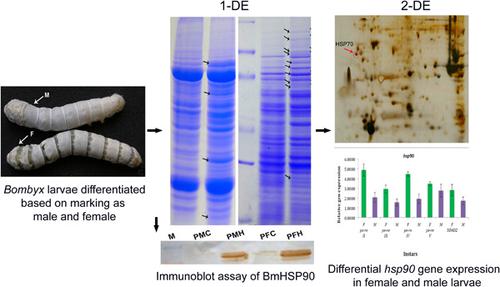当前位置:
X-MOL 学术
›
Arch. Insect Biochem. Physiol.
›
论文详情
Our official English website, www.x-mol.net, welcomes your
feedback! (Note: you will need to create a separate account there.)
Comprehensive analysis of differentially expressed proteins in the male and female Bombyx mori larval instars exposed to thermal stress.
Archives of Insect Biochemistry and Physiology ( IF 1.5 ) Pub Date : 2020-06-09 , DOI: 10.1002/arch.21719 Punyavathi 1 , H B Manjunatha 1
Archives of Insect Biochemistry and Physiology ( IF 1.5 ) Pub Date : 2020-06-09 , DOI: 10.1002/arch.21719 Punyavathi 1 , H B Manjunatha 1
Affiliation

|
Gender sensitivity to ambient heat, despite well known in insect species, how it manifests during young and late larval instars of Bombyx mori is still unclear. To uncover this cryptic feature, different instars male and female larvae were subjected to varied thermal stress separately and sex‐stage specific expression of proteins was investigated. Interestingly, heat shock proteins (HSPs) 90 and 70 were expressed differently in all the instars and also between male and female larvae as confirmed by immunoblot assay. Besides up‐ and downregulation of few HSPs and other normal proteins, discreet expression of protein was noticed in the two‐dimensional gel electrophoresis of male than female larvae which were identified as HSP70 by mass spectrometry. Furthermore, quantitative polymerase chain reaction results show 3.98‐ and 4.86‐fold higher levels of Bmhsp70 and Bmhsp90 transcripts in male and female larvae, respectively, as a response to 40°C heat shock (HS) treatment. Conversely, in spite of the massive production of HSPs due to HS at 45°C, all the larvae were found dead, which is a strong proof of concept for autophagy. Comparatively, female larvae HS at 40°C succeed to spin cocoons with increased weight and silk contents than non‐HS larvae. Comprehensively, in the present study, we have noticed a strong correlation for the first time that Bmhsp90 and Bmhsp70 genes expressions due to thermal stress are not only sex specific but also explicit preferential and coordinated action on survivability and biosynthetic potential of the silkworm, B. mori larvae during different instars.
中文翻译:

综合分析暴露于热应激的雄性和家蚕幼虫中差异表达的蛋白质。
性别对环境热的敏感性,尽管在昆虫物种中广为人知,但如何在家蚕幼虫和晚期幼虫期表现出来仍不清楚。为了揭示这种隐秘特征,对不同龄期的雄性和雌性幼虫分别进行不同的热应激,并研究了蛋白质的性别阶段特异性表达。有趣的是,通过免疫印迹分析证实,热休克蛋白(HSP)90和70在所有幼虫中以及雄性和雌性幼虫中均表达不同。除了少数HSP和其他正常蛋白质的上调和下调外,在雄性比雌性幼虫的二维凝胶电泳中还发现蛋白质的离散表达,质谱鉴定为HSP70。此外,定量聚合酶链反应结果显示,Bmhsp70和Bmhsp90的水平分别高3.98和4.86倍分别在雄性和雌性幼虫中转录本,作为对40°C热休克(HS)处理的反应。相反,尽管由于45°C的HS导致HSP大量生产,但发现所有幼虫均已死亡,这是自噬概念的有力证明。相比之下,与非HS幼虫相比,在40°C时,雌性幼虫HS成功纺出重量和丝含量增加的茧。综上所述,在本研究中,我们首次注意到由于热应激而引起的Bmhsp90和Bmhsp70基因表达不仅具有性别特异性,而且对蚕B的生存能力和生物合成潜力具有明确的优先和协调作用。在不同龄期的桑蚕幼虫。
更新日期:2020-06-09
中文翻译:

综合分析暴露于热应激的雄性和家蚕幼虫中差异表达的蛋白质。
性别对环境热的敏感性,尽管在昆虫物种中广为人知,但如何在家蚕幼虫和晚期幼虫期表现出来仍不清楚。为了揭示这种隐秘特征,对不同龄期的雄性和雌性幼虫分别进行不同的热应激,并研究了蛋白质的性别阶段特异性表达。有趣的是,通过免疫印迹分析证实,热休克蛋白(HSP)90和70在所有幼虫中以及雄性和雌性幼虫中均表达不同。除了少数HSP和其他正常蛋白质的上调和下调外,在雄性比雌性幼虫的二维凝胶电泳中还发现蛋白质的离散表达,质谱鉴定为HSP70。此外,定量聚合酶链反应结果显示,Bmhsp70和Bmhsp90的水平分别高3.98和4.86倍分别在雄性和雌性幼虫中转录本,作为对40°C热休克(HS)处理的反应。相反,尽管由于45°C的HS导致HSP大量生产,但发现所有幼虫均已死亡,这是自噬概念的有力证明。相比之下,与非HS幼虫相比,在40°C时,雌性幼虫HS成功纺出重量和丝含量增加的茧。综上所述,在本研究中,我们首次注意到由于热应激而引起的Bmhsp90和Bmhsp70基因表达不仅具有性别特异性,而且对蚕B的生存能力和生物合成潜力具有明确的优先和协调作用。在不同龄期的桑蚕幼虫。











































 京公网安备 11010802027423号
京公网安备 11010802027423号